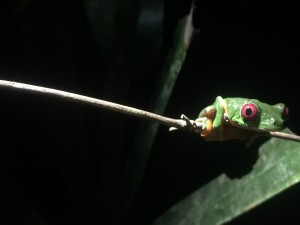Alarms here at the Gamboa Schoolhouse sound far earlier than any alarm I have set for an early class. But with only 12 days in the neotropics to hike, kayak, eat, meet natives, and attempt to understand the functions of this place’s natural beauty, our days must be stretched as much as possible – 5am breakfasts are welcomed with enthusiasm (more so when pancakes are involved), when we’re likely the most positive and high-functioning OSU undergraduates on Earth. Here the early hiker gets the bird, and Panama has rewarded us with 40+ different bird species, multiple monkey encounters, and long views of not-quite-yet blistering hot roadside (and riverside) culture. Getting out and under the cover of the forest canopy before midday is rewarding in itself – multiple 6+ mile hikes have left us drenched in sweat before lunch, but 90 degrees and 90% humidity seems to be more than bearable when searching for howlers amid massive palms and webs of lianas. Needless to say, after we fill our starved stomachs with Senora Francis’ home cooked dinners, we’re lucky to make it past 9pm without coffee. But Thursday night, we decided to chug the dark stuff and and skip the afternoon heat in a different way – by heading outside after dark.
After finally determining how to not blind the person we’re attempting to talk with – headlamps are not to be trusted with caffeinated undergraduates – we made our way through Gamboa, suddenly much more foreign that it had seemed. The sheer volume of sounds still coming from the surrounding rain forest was almost unmistakable from our morning hikes, with just as many insects, frogs, birds and chirpy geckos contributing to the eerie chorus. A true appreciation of how many individual life forms were present around us, even while still in the village, didn’t come into view until someone shined a beam of light onto the overgrown futbol field, pointed and said “spider eyes”. Thousands of tiny green lights reflected back at us. We walked a little more carefully.
Keeping a slowly-adjusted eye at our feet for venomous snakes and tarantulas, we made our way to a small creek running along Gamboa’s perimeter. Amphibians were the catch-of-the-day here. At least 5 different species of new toads and frogs popped into view after short searches; this was their time, they weren’t trying to hide. More than any others, the seemingly abrupt appearance of dozens of bright Red-Eyed Tree Frogs in the low hanging tree branches blew us away.
These frogs live almost exclusively in jungle trees – hunting insects, breeding, and laying their eggs on the large leaves. Many researchers think the shocking red eyes and yellow-and-blue stomach developed to make predators to at least take an extra minute to consider them before chomping down, and ironically enough they seem to have the same effect on us humans. These colors also make them popular pets, and while their populations here in Panama are still running strong in the forest evenings, their numbers are dropping. They are known as an indicator species; frogs and salamanders, while growing up into adults in water, are extremely sensitive to changes in water quality, like pollution and added sediments. Human waste and changes to the soil structure from spreading agriculture, when applied to these fragile jungle ecosystems, quickly wipe out frogs before most other types of animals, indicating that the jungles are beginning to suffer. We were overjoyed to see them so close to humanized areas, but we also wondered how much longer they would be able to occupy that particular stream.
Nocturnal wasps, mayflies and two small frog-eating snakes also graced us with their presence, but the quick and unsure sightings are what got our blood-pumping. Caimans, a smaller and shier cousin to the crocodile, may have darted away as soon as our headlamps announced our presence, heading into the darker deeper waters of the creek. On top of it all through, staring down at us from the ridges above the creek before slinking away to find his dinner of other mammals – an ocelot, or perhaps a puma.
Incredibly rare to encounter because of their nocturnal habits, these big cats roam large territories throughout Central America, acting as top predators in jungle food webs. Cats like these can often act as keystone species – animals that, if removed from an ecosystem, would have massive effects on the food web beneath them. Without them to control prey mammals and other vertebrates, these populations would spike, creating more herbivores and in turn dropping rare plant number throughout these systems. All of these species-of-the-night play an essential role in most species that are active throughout the day. We, as a species, need more night hikes.
References:
http://animaldiversity.org/site/accounts/information/agalychnis_callidryas.html
http://animals.nationalgeographic.com/animals/amphibians/red-eyed-tree-frog/



